This post may contain affiliate links. Please read our disclosure policy.
This popular snack in Medan is made with savory jicama and carrot filling enclosed in soft and slightly chewy sweet potato dough. The sweet potato dough recipe is easy to work with and resistant to tear. The chai pau dumplings stay soft.
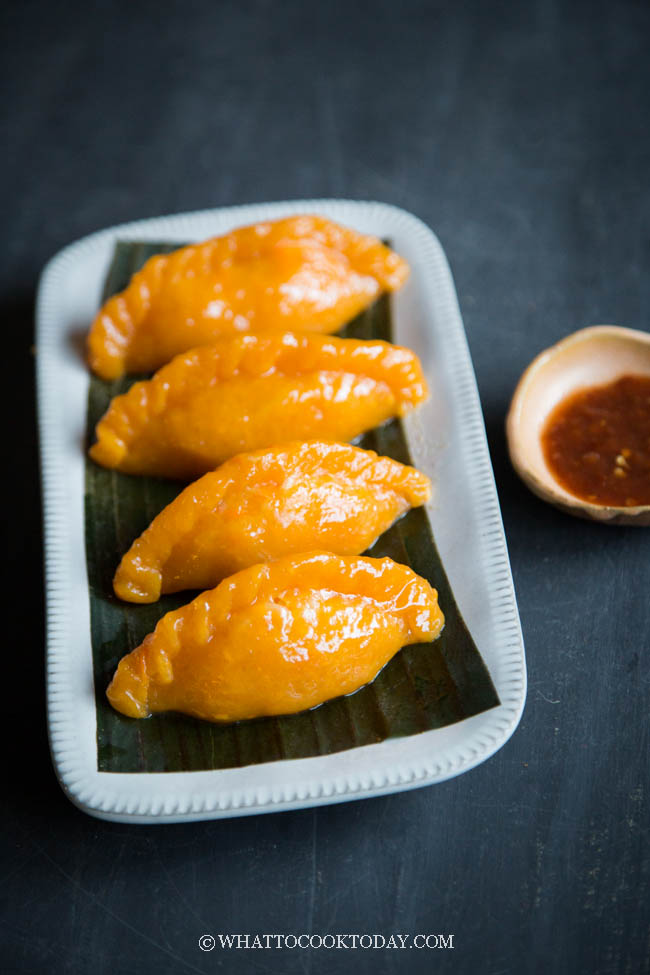
One of the popular snacks I used to eat as a kid is this chai pau ubi Medan. Medan is the city I grew up in as a kid. Chai means vegetable, Pau roughly means a wrap, and Ubi means sweet potato and there you have it, vegetable dumpling in sweet potato wrap.
The Chai Kueh in Singapore and Malaysia is slightly different than the one we have in Medan. The dough is made with just starches and this chai pau ubi has mashed sweet potatoes. But I love them both. There is also another version known as choi pan, which is similar to Singapore and Malaysia version of chai kueh.
WHY YOU’LL LIKE THIS RECIPE
1. The dough is easy to work with
One of the things that people afraid of the most when it comes to making chai pau ubi is the dough. The dough tears during wrapping and shaping, which was so frustrating. I have tried so many different sweet potato and tapioca starch ratios, so many different methods and finally, this is it! I couldn’t be happier with the result. The dough is incredibly easy to work with and resistant to tear
2. Chai pau stays soft even after the next day
I keep them at room temperature to see and they stay soft
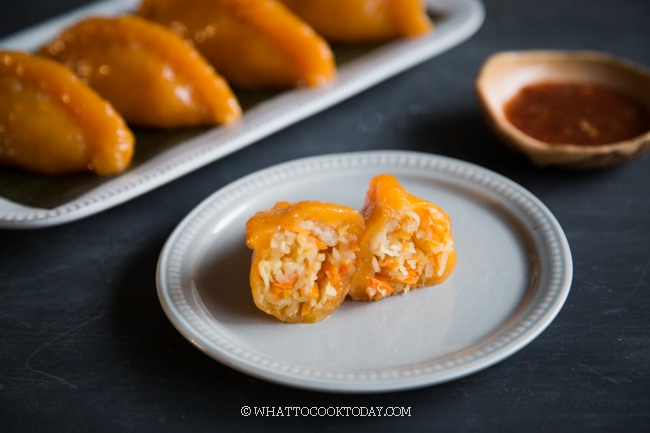
If you have never tried jicama, you should. This tuber is crunchy and sweet in nature and commonly used in Southeast Asia. My mom sometimes cooks the filling as a side dish to go with rice. Super yummy! I forgot to take the step-by-step photo when cooking the filling, but it’s pretty straightforward.

Fillings for Chai Pau made with shredded jicama and carrots
HOW TO MAKE CHAI PAU UBI MEDAN
1. Prepare the dough
Put the sweet potato pieces in a saucepan. Pour in water, just enough to cover the sweet potato.
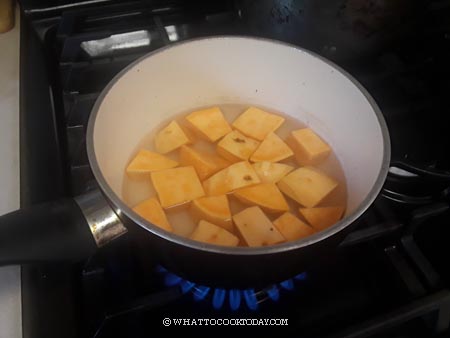
Boil the sweet potato until fork-tender, about 5-8 minutes or longer depending on the size you cut.
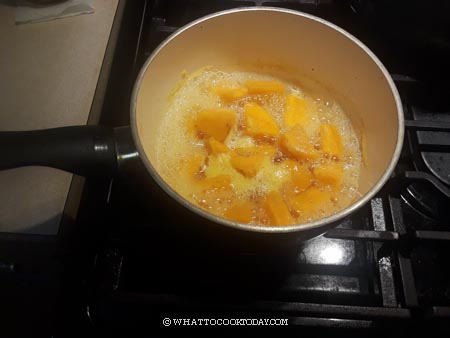
Immediately remove the boiling hot sweet potato pieces and put them inside the mixing bowl that has tapioca starch in there. Keep the boiling water in case you need it.
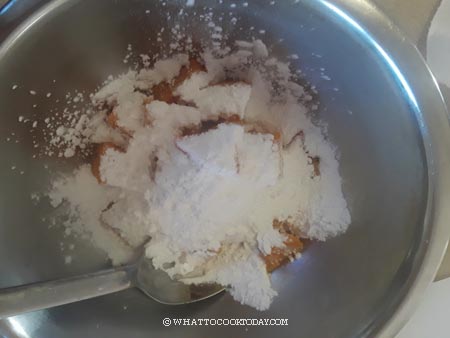
Use a potato masher or a fork to mash the sweet potatoes together with the tapioca starch. This is the key to making a chai pau dough that is resistant to tear. The heat from the sweet potatoes will “cook” the tapioca starch at the same time as you mash them together, making the dough flexible and resilient
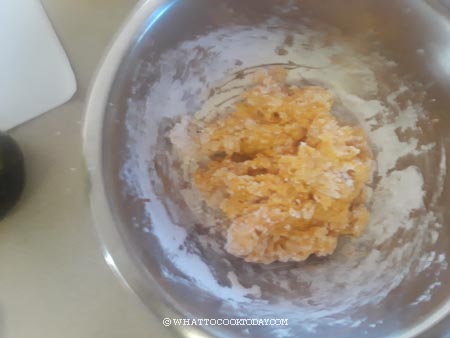
When it’s not so hot anymore, use your hand to knead the dough. It should form a sticky dough. I don’t need to add any liquid at all. This depends on your sweet potatoes too.
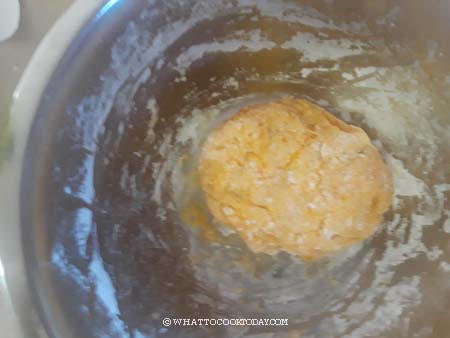
Add 1 Tbsp of oil and continue to knead. The dough is much easier to handle now with the oil and you will be able to form one dough mass. The dough may be still a bit sticky to touch, but not too much. If it is too sticky, you may add a teaspoon of tapioca starch or more as needed. If it’s too dry, then you can add a bit of the liquid from cooking the sweet potatoes, make sure the liquid is still hot. Don’t keep adding starch. The more starch you add, the tougher the dough going to be. Cover it and let it rest for 15 minutes or longer. It is important to rest the dough
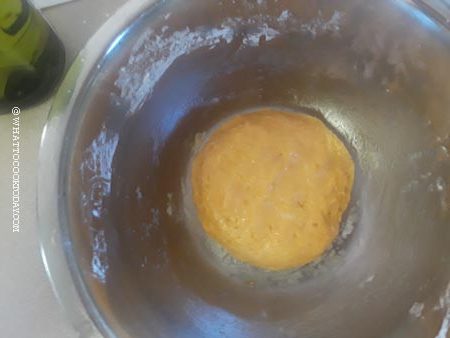
2. Wrapping
After the rest, you will find that the dough is even more flexible and resilient now. Divide the dough into 14 equal pieces, roughly about 40 grams each. I find that 50 grams is too big. I prefer 40 grams for each dough
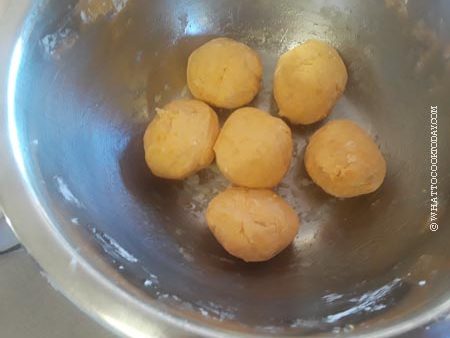
You can roll the dough out using a rolling pin into a circle
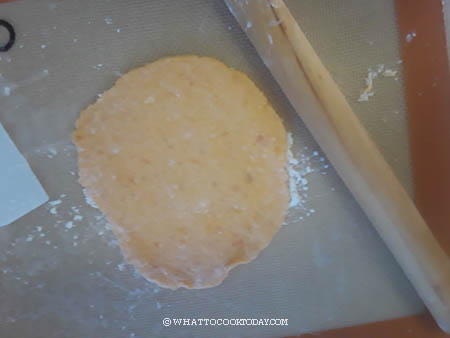
Put a filling in the middle and fold it over to form a half-circle shape. Pinch the top to seal.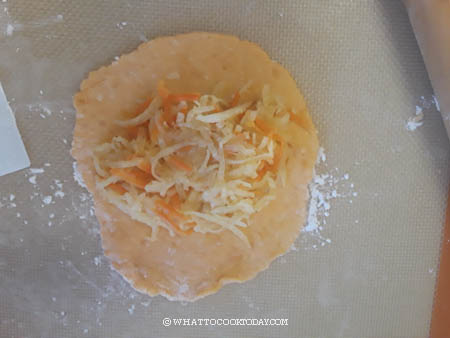
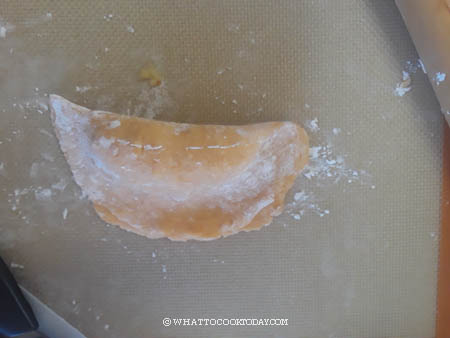
You can trim off excess dough on top with a kitchen shears if needed
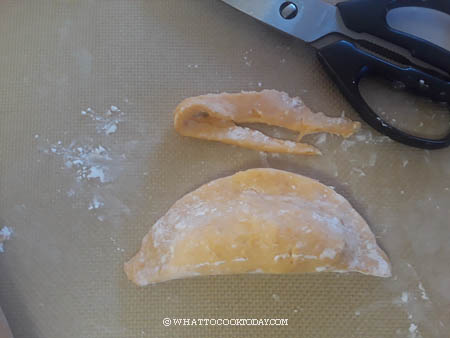
My favorite way of wrapping is to roll the dough into a ball and then push your thumb into the middle of the ball and using your thumb and index finger (dust them with a bit of tapioca starch)
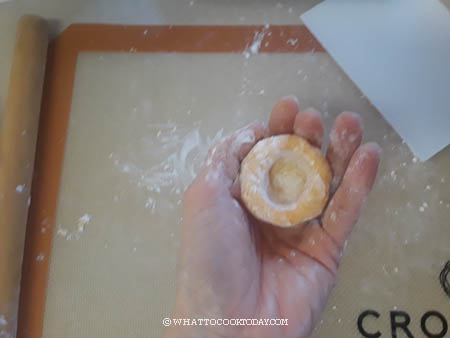
Fo around the side to form a bowl
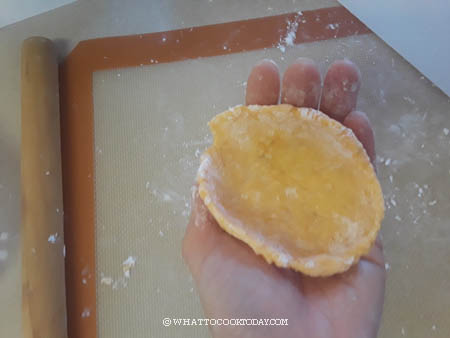
Put the filling in and use the back of the spoon to press the filling to pack it down and then seal the top. Repeat with the rest
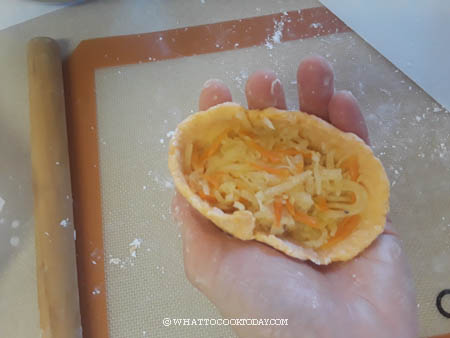
3. Cook the chai pau ubi
Bring the water in a steamer to a rolling boil. Place a piece of banana leaves on top of the steamer rack and brush with some oil.
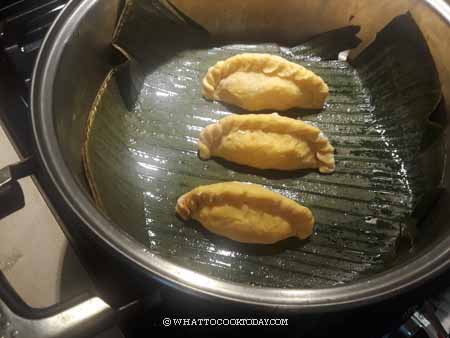
Arrange the chai pao on top and steam on high heat for 12-15 minutes. The skin will turn bright orange and slightly transparent.
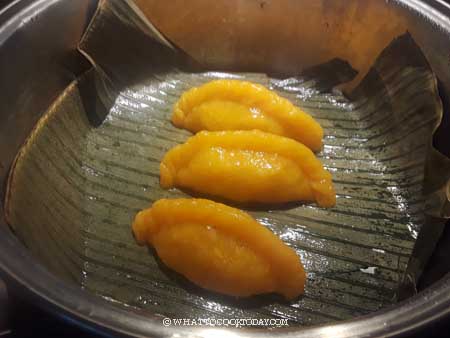
Remove from the steamer and let them cool down. They appear to be very soft when they just come out from the steamer. 10-15 minutes later, you can easily move them to a serving platter. Brush with a bit of oil and serve with the chili sauce
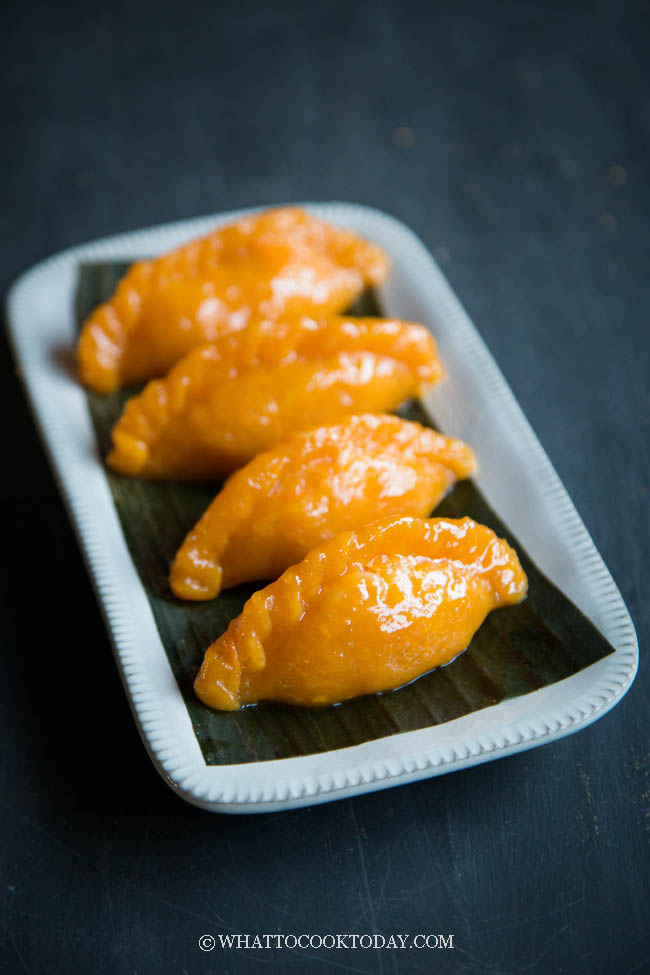
IMPORTANT TIPS
1. Don’t steam the sweet potato. Boil them as directed in the recipe
2. It is very important that the sweet potato pieces are really hot when you mash them
3. It is important to mash the sweet potato pieces together with the tapioca starch. Don’t mash the sweet potato pieces separately and then add the tapioca starch. The heat from the sweet potato helps to “cook” the tapioca starch making the dough resistant to tear

DID YOU MAKE THIS CHAI PAU UBI MEDAN RECIPE?
I love it when you guys snap a photo and tag to show me what you’ve made 🙂 Simply tag me @WhatToCookToday #WhatToCookToday on Instagram and I’ll be sure to stop by and take a peek for real!

The recipe was first published in 2017 and now it has been improved and also to include new photos on September 2020.
Chai Pau Ubi Medan/ Chai Kueh (Steamed Vegetable Dumplings)
Ingredients
Fillings:
- 250 gr shredded jicama
- 100 gr shredded carrots
- 50 gr green beans cut off both ends and chopped
- 2 Tbsp cooking oil
- 4 cloves garlic peeled and finely minced
- 100 gr shrimp optional, peeled, deveined and chop finely
- 1 tsp sugar or more to taste
- Salt to taste
Dough:
- 200 gr peeled sweet potatoes cut into small cubes
- 80 gr tapioca starch plus more for dusting
- ½ tsp salt
- 1 Tbsp cooking oil
Chili sauce:
- 3 red jalapeno peppers or you can use 2-3 Tbsp of store-bought sambal oelek
- 2 cloves garlic
- 1 tsp salt
- 1 Tbsp sugar
- 1 tsp vinegar or juice of a lime
Instructions
Prepare the filling (can be prepared few days before and keep in the fridge):
- Preheat oil in a large wok or skillet. Saute the garlic for about 10 seconds, add the shrimp (if using) and cook until they turn color, about 30 seconds or so. Add the jicama and carrots and cook until they are soft. Add salt and sugar stir to mix everything. Have a taste and season with more salt or sugar to your taste. Remove from the heat and let it cool off completely before wrapping
Prepare chili sauce:
- Place all the chili sauce ingredient in a food processor and blend until smooth. Pour into a small saucepan and cook until the sugar dissolves. The sauce should be slightly sweet and tangy. Adjust by adding more sugar or vinegar to your liking. It should be spicy with slightly tang and just hint of sweetness
Prepare the dough:
- Pour in 80 grams of tapioca starch in large mixing bowl. Add salt and stir to mix. Set aside. Get this ready before you cook the sweet potatoes
- Put the sweet potato pieces in a saucepan. Pour in water, just enough to cover the sweet potato. Boil the sweet potato until fork-tender, about 5-8 minutes or longer depending on the size you cut. Immediately remove the boiling hot sweet potato pieces and put them inside the mixing bowl that has tapioca starch in there. Keep the boiling water in case you need it. Use a potato masher or a fork to mash the sweet potatoes together with the tapioca starch. This is the key to making a chai pau dough that is resistant to tear. The heat from the sweet potatoes will "cook" the tapioca starch at the same time as you mash them together, making the dough flexible and resilient
- When it's not so hot anymore, use your hand to knead the dough. It should form a sticky dough. I don't need to add any liquid at all. This depends on your sweet potatoes too. Add 1 Tbsp of oil and continue to knead. The dough is much easier to handle now with the oil and you will be able to form one dough mass. The dough may be still a bit sticky to touch, but not too much. If it is too sticky, you may add a teaspoon of tapioca starch or more as needed. If it's too dry, then you can add a bit of the liquid from cooking the sweet potatoes, make sure the liquid is still hot. Don't keep adding starch. The more starch you add, the tougher the dough going to be. Cover it and let it rest for 15 minutes or longer. It is important to rest the dough
Wrapping:
- After the rest, you will find that the dough is even more flexible and resilient now. Divide the dough into 14 equal pieces, roughly about 40 grams each. I find that 50 grams is too big. I prefer 40 grams for each dough
- You can roll the dough out using a rolling pin into a circle and then put a filling in the middle and fold it over to form a half-circle shape. Pinch the top to seal. My favorite way of wrapping is to roll the dough into a ball and then push your thumb into the middle of the ball and using your thumb and index finger (dust them with a bit of tapioca starch) to go around the side to form a bowl (refer to photo above). Put the filling in and use the back of the spoon to press the filling to pack it down and then seal the top. Repeat with the rest
Steaming:
- Bring the water in a steamer to a rolling boil. Place a piece of banana leaves on top of the steamer rack and brush with some oil. Arrange the chai pao on top and steam on high heat for 12-15 minutes. The skin will turn bright orange and slightly transparent. Remove from the steamer and let them cool down. They appear to be very soft when they just come out from the steamer. 10-15 minutes later, you can easily move them to a serving platter. Brush with a bit of oil and serve with the chili sauce
Storing:
- The chai pau dough doesn't get tough even after a day at room temperature. You can store them at room temperature for a maximum one day and then keep them in the fridge and reheat in the steamer or microwave to warm them up
- For longer storage, I recommend freezing the uncooked chai pau instead. Place them on a baking sheet lined with a parchment paper, not touching each other for about 1 hour. Then transfer to a freezer bag and they won't stick to each other anymore. They can be kept for up to one month max
- When ready to serve, do not thaw, they can be steamed straight from frozen following the steaming method above. The cooking time might be a bit longer if they are frozen



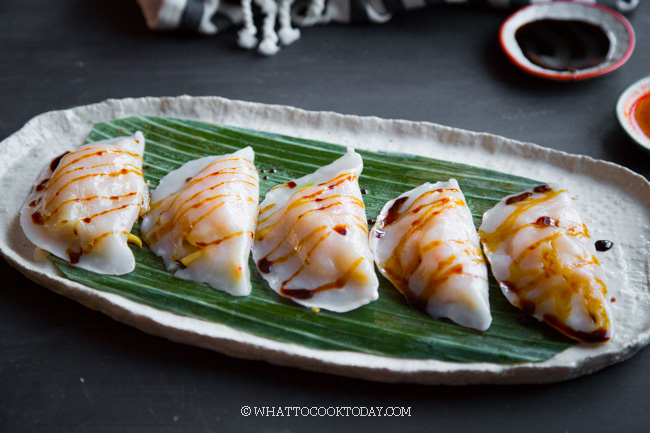

4 comments
will try this one! 🙂
oh…let me know how they turn out 🙂
Such an interesting recipe! I love the dumpling dough and definitely want to try it. I wonder if it will work with cassava flour, or if you really, really need to have the higher starch content as in tapioca. Cute story about how you used to get these as a girl:)
Hi Milena, I believe it might work. I haven’t tried it with cassava flour to be honest.